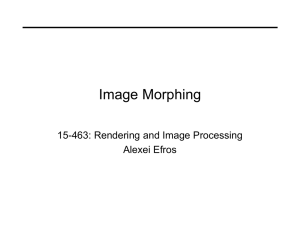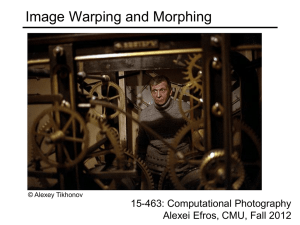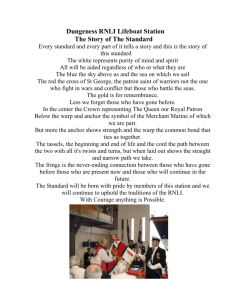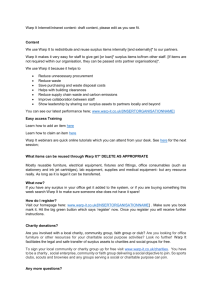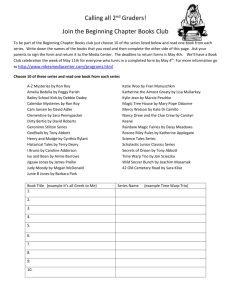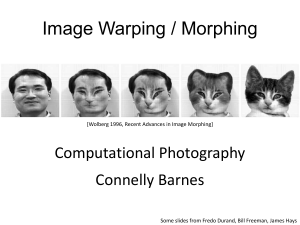Image Morphing Morphing = Object Averaging
advertisement
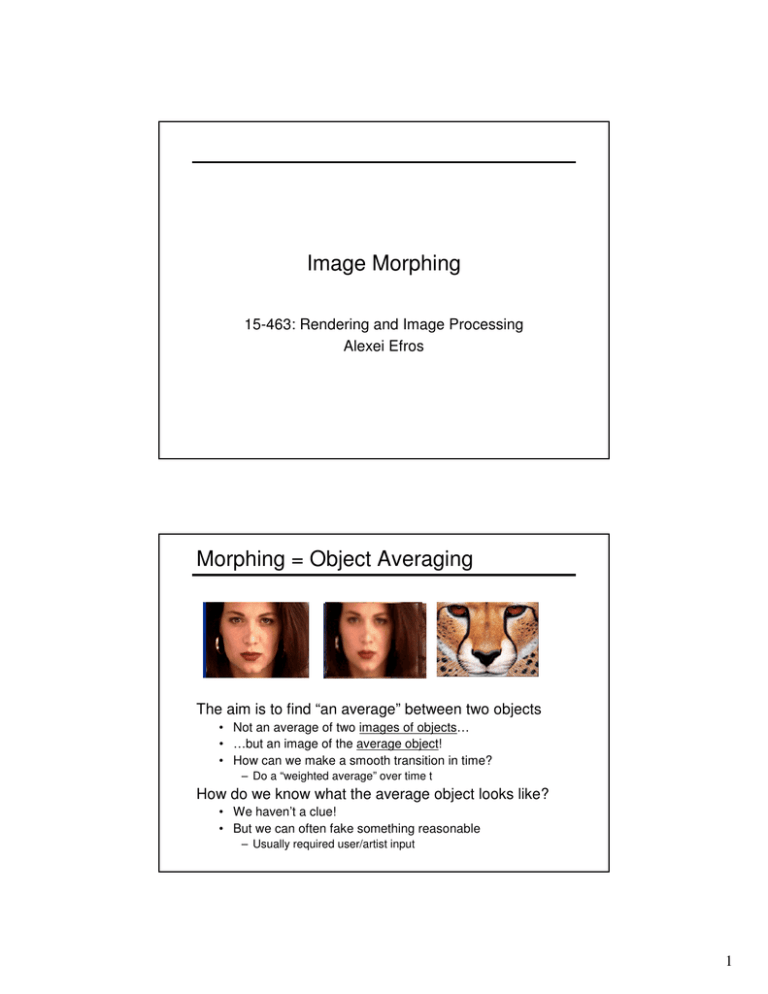
Image Morphing 15-463: Rendering and Image Processing Alexei Efros Morphing = Object Averaging The aim is to find “an average” between two objects • Not an average of two images of objects… • …but an image of the average object! • How can we make a smooth transition in time? – Do a “weighted average” over time t How do we know what the average object looks like? • We haven’t a clue! • But we can often fake something reasonable – Usually required user/artist input 1 Averaging Points Q What’s the average of P and Q? v=Q-P P Linear Interpolation (Affine Combination): New point aP + bQ, defined only when a+b = 1 So aP+bQ = aP+(1-a)Q P + 0.5v = P + 0.5(Q – P) = 0.5P + 0.5 Q P + 1.5v = P + 1.5(Q – P) = -0.5P + 1.5 Q (extrapolation) P and Q can be anything: • points on a plane (2D) or in space (3D) • Colors in RGB or HSV (3D) • Whole images (m-by-n D)… etc. Idea #1: Cross-Dissolve Interpolate whole images: Imagehalfway = t*Image1 + (1-t)*image2 This is called cross-dissolve in film industry • Note similarity to alpha blending! But what is the images are not aligned? 2 Idea #2: Align, then cross-disolve Align first, then cross-dissolve • Alignment using global warp – picture still valid Dog Averaging What to do? • Cross-dissolve doesn’t work • Global alignment doesn’t work – Cannot be done with a global transformation (e.g. prospective) • Any ideas? Feature matching! • Nose to nose, tail to tail, etc. – This is a local (non-parametric) warp 3 Idea #3: Local warp, then cross-dissolve Morphing procedure: for every t, 1. Find the average shape (the “mean dog”☺) • local warping 2. Find the average color • Cross-dissolve the warped images Local (non-parametric) Image Warping Need to specify a more detailed warp function • Global warps were functions of a few (2,4,8) parameters • Non-parametric warps u(x,y) and v(x,y) can be defined independently for every single location x,y! • Once we know vector field u,v we can easily warp each pixel (use backward warping with interpolation) Optical flow is just such a vector field • Will it work for these dogs? • Probably not… Need user control. 4 Image Warping – non-parametric Move control points to specify a spline warp Spline produces a smooth vector field Warp specification How can we specify the warp? 3. Specify corresponding spline control points • interpolate to a complete warping function But we want to specify only a few points, not a grid 5 Warp specification How can we specify the warp? 1. Specify corresponding points • • interpolate to a complete warping function How do we do it? Triangular Mesh 1. Input correspondences at key feature points 2. Define a triangular mesh over the points • • Same mesh in both images! Now we have triangle-to-triangle correspondences 3. Warp each triangle separately from source to destination • • • How do we warp a triangle? 3 points = affine warp! Just like texture mapping 6 Triangulations A triangulation of set of points in the plane is a partition of the convex hull to triangles whose vertices are the points, and do not contain other points. There are an exponential number of triangulations of a point set. An O(n3) Triangulation Algorithm Repeat until impossible: • Select two sites. • If the edge connecting them does not intersect previous edges, keep it. 7 “Quality” Triangulations Let α(T) = (α1, α2 ,.., α3t) be the vector of angles in the triangulation T in increasing order. A triangulation T1 will be “better” than T2 if α(T1) > α(T2) lexicographically. The Delaunay triangulation is the “best” • Maximizes smallest angles good bad Improving a Triangulation In any convex quadrangle, an edge flip is possible. If this flip improves the triangulation locally, it also improves the global triangulation. If an edge flip improves the triangulation, the first edge is called illegal. 8 Illegal Edges Lemma: An edge pq is illegal iff one of its opposite vertices is inside the circle defined by the other three vertices. Proof: By Thales’ theorem. p q Theorem: A Delaunay triangulation does not contain illegal edges. Corollary: A triangle is Delaunay iff the circle through its vertices is empty of other sites. Corollary: The Delaunay triangulation is not unique if more than three sites are co-circular. O(n4) Delaunay Triangulation Algorithm Repeat until impossible: • Select a triple of sites. • If the circle through them does not contain other sites, keep the triangle whose vertices are the triple. 9 Naïve Delaunay Algorithm Start with an arbitrary triangulation. Flip any illegal edge until no more exist. Requires proof that there are no local minima. Could take a long time to terminate. Delaunay Triangulation by Duality General position assumption: There are no four co-circular points. Draw the dual to the Voronoi diagram by connecting each two neighboring sites in the Voronoi diagram. Corollary: The DT may be constructed in O(nlogn) time. 10 Warp specification How can we specify the warp? 2. Specify corresponding vectors • • interpolate to a complete warping function The Beier & Neely Algorithm Beier&Neely (SIGGRAPH 1992) Single line-pair PQ to P’Q’: 11 Algorithm (single line-pair) For each X in the destination image: 1. Find the corresponding u,v 2. Find X’ in the source image for that u,v 3. destinationImage(X) = sourceImage(X’) Examples: Multiple Lines Length = length of the line segment, dist = distance to line segment a, p, b – constants. What do they do? 12 Resulting warp (complex!) Full Algorithm 13 Results Dynamic Scene 14 Image Morphing We know how to warp one image into the other, but how do we create a morphing sequence? 1. Create an intermediate warping field (by interpolation) 2. Warp both images towards it 3. Cross-dissolve the colors in the newly warped images Warp interpolation How do we create an intermediate warp at time t? For optical flow? • Easy. Interpolate each flow vector • That’s how interframe interpolation is done For feature point methods • Simple linear interpolation of each feature pair (e.g. 0.5p1+0.5p0 for the middle warp) For Beier-Neely? • Can do the same for line end-points • But what could happen? • A line rotating 180 degrees will become 0 length in the middle • One solution is to interpolate line mid-point and orientation angle • Not very intuitive 15 Other Issues Beware of folding • Can happen in any of the methods • You are probably trying to do something 3D-ish Morphing can be generalized into 3D • If you have 3D data, that is! Extrapolation can sometimes produce interesting effects • Caricatures Video Matching 16
